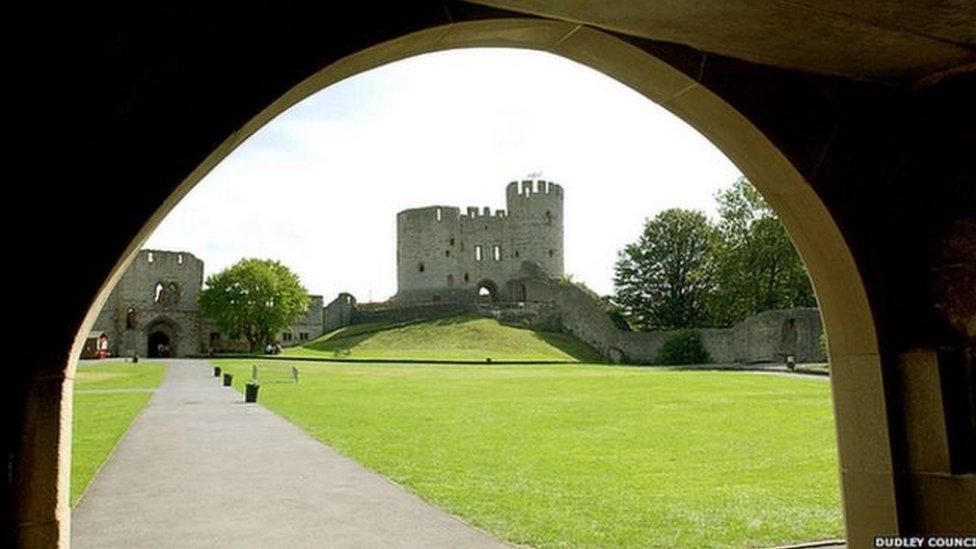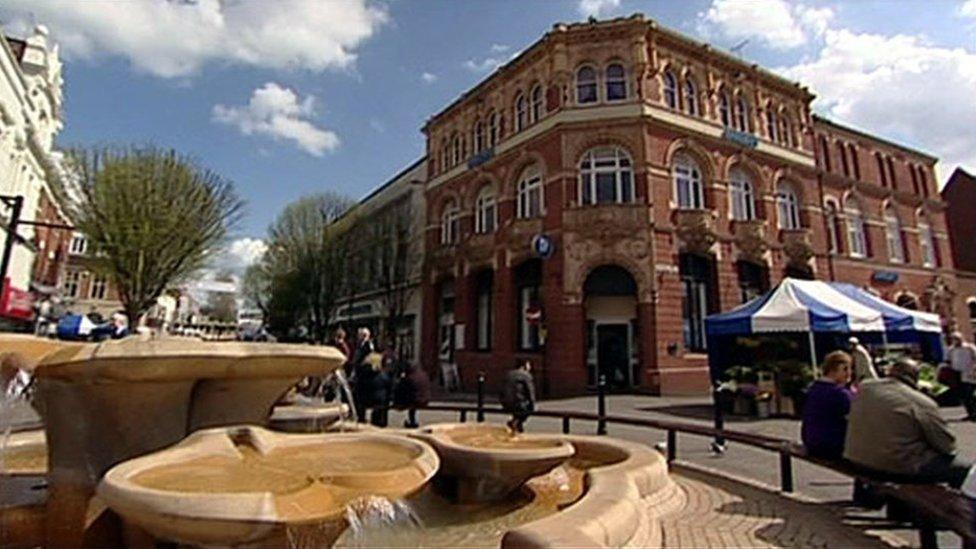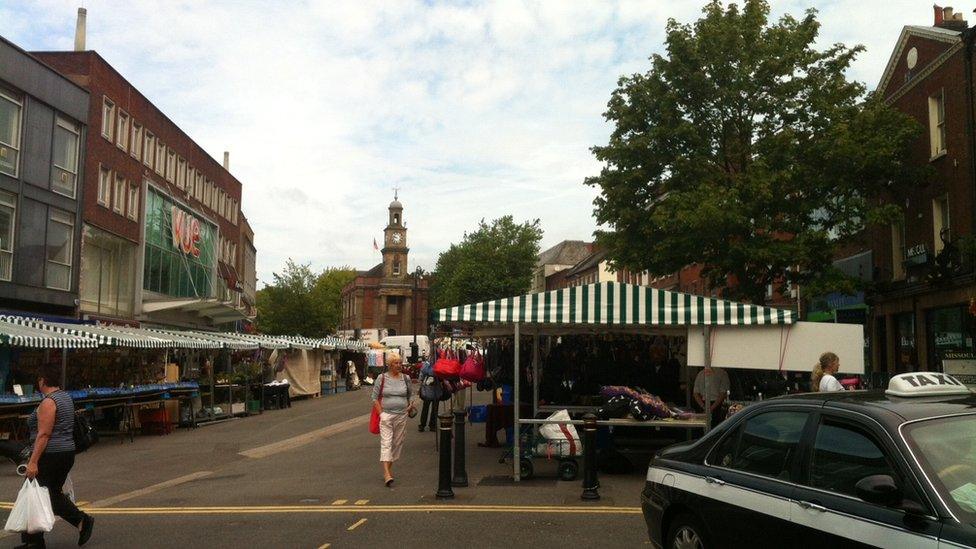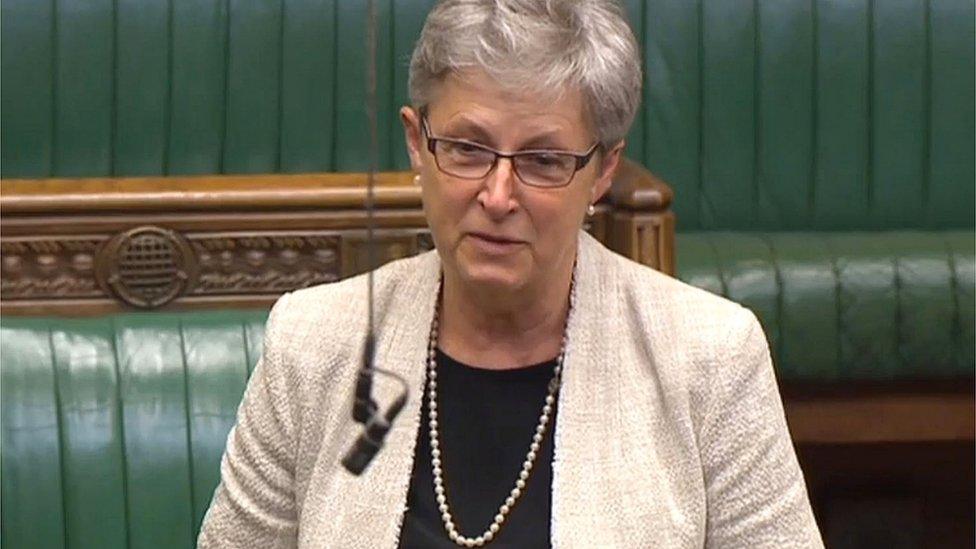Who'll call the tune in June if the Midlands swings?
- Published

Dudley North: Where Labour could be vulnerable
"It ain't got a thing if it ain't got that swing."
That's what the old song says.
But it could just as well become the mantra for the parties' election strategists composing the mood music for that snap general election on Thursday 8 June.
Nowhere more so than in this region of swing seats seen, yet again, as key to deciding who wins and loses.
If the opinion polls are anywhere near right, and recent history reminds us they may not be, then Labour face a tough fight to hang on to what they hold. Nowhere more so than in:
Newcastle-under-Lyme
Labour MP Paul Farrelly's slender 650 majority puts his seat at the top of the Conservatives' target list in our part of the country. They require a swing of under 0.8%. And Mr Farrelly's determined opposition to Brexit may not exactly help either, in a constituency which overwhelmingly voted Leave. He was the only Midlands Labour MP to defy his party and vote against Theresa May triggering Article 50.
Wolverhampton South West

Nuneaton was the 'weather vane' constituency which set David Cameron onto victor in the 2015 general election
Labour's Rob Marris lost this perpetual swing seat to the Conservatives in 2010 but regained it from them in 2015. This time he has decided to go of his own accord. Having already announced his decision to stand down he invites the inevitable charge that he has jumped before the Tories push him. They require a swing here of just 1.0%.
Birmingham Northfield
Once regarded as another swing seat, Northfield has developed an air of permanence in Labour's hands. It's been held ever since 1992 by Shadow Transport Minister Richard Burden, despite a concerted challenge by David Cameron's party in 2015. But Mr Burden may find it harder to survive this time. The Conservatives need a swing of under 3%.
To this 'top three' we can add further seats where Labour would be vulnerable according to the current ratings. In alphabetical order:
Birmingham Edgbaston where Gisela Stuart, "the poster girl" of Labour 1997 landslide and more recently the chair of Vote Leave, is standing down;
two of the Coventry seats, South and North West;
Dudley North;
Walsall North.
But if the Labour Leader Jeremy Corbyn is right that the election "is not a foregone conclusion", then his strategists will have their eyes on those seats where the Conservatives have majorities under 5,000:
Telford

Newcastle-under-Lyme is top of the Conservatives' target list in the West Midlands
Even though the Conservatives won an overall majority in 2015, this was the only Midlands seat they gained from Labour. This time, Lucy Allan's 730 majority could look even more perilous if the apparently endless tug-of-war over the centralisation of Shropshire's hospital services either in her town or in Shrewsbury inflicts collateral damage on her campaign. Labour need a swing of under 1%.
Warwickshire North
Labour missed out on their prime Midlands target last time. In the event, the Conservatives increased their majority to just under 3,000. But in an area which includes the former mining areas around Atherstone and Coleshill, this has to be on Labour's hit-list once again. They need a swing of 3.2% .
Halesowen and Rowley Regis
Another of Labour's missed targets in 2015. The incumbent Conservative, James Morris, increased his majority to over 3,000. But this seat is a solitary example of Tory blue in the Labour stronghold of Sandwell, so they will be fighting hard for the 3.5% swing they need to unseat him.
Labour will also be challenging to recapture seats they held before 2015 in industrial areas like Cannock Chase, Redditch and, of course, Nuneaton, that weather-vane seat which set David Cameron on course for victory last time.
No less intriguing is the question whether the Liberal Democrats will capitalise on what they see as their Brexit bounce: (anti-Brexit bounce, more like). Cheltenham is one of very few Midlands towns which voted to Remain in the EU. The Lib Dems still control the local council and had held the seat in Parliament since 1992 until the Conservative Alex Chalk won his majority of over 6,500 in 2015. The former Liberal Democrat MP Martin Horwood will be fighting hard for the swing of just over 6% he would need to regain it. Another Liberal Democrat unseated in 2015, John Hemming, may find it tougher to regain Birmingham Yardley. He would need to overturn the majority of over 6,500 achieved by one of Labour's most conspicuous rising stars, Jess Phillips.

Gisela Stuart, MP for Birmingham Edgbaston and also the recent the chair of Vote Leave, is standing down
And what of UKIP?
They are under intense pressure after their series of well-documented setbacks following Nigel Farage's departure from the leadership and the failure of his successor, Paul Nuttall, in February's Stoke Central by-election. They will look again to Stoke and the Black Country to dispel suggestions that the achievement of their founding objective, Brexit, leaves them without a convincing role under a Conservative government committed to Britain's withdrawal from the EU.
The prism of Brexit
All this brings us, inevitably, to the reason why this is an election like no other. The conventional number-crunching which I have set out so far tells us significantly less than usual about the outcome in our region which recorded the UK's highest proportion of Leave votes, especially in Labour's traditional 'core' areas. Since that referendum, the signs are that attitudes are, if anything, polarising on both sides.
Looking at this election through that defining "prism" of Brexit raises the question whether perceptions of Jeremy Corbyn's lukewarm attitude to Europe and of his party's half-hearted approach to Brexit could leave them stranded between one side and the other.
Might this leave them vulnerable in far less obvious seats like Erdington and Selly Oak in Birmingham, with voters switching to either the Conservatives or Liberal Democrats depending on their position on Europe?
Elsewhere, the Conservatives' message that "we're the party of Brexit now" will be aimed at potential UKIP deserters in the Potteries and the Black Country. Could this also bring other equally unlikely-sounding Labour seats (Stoke North and Central, Wolverhampton North East, West Bromwich West, for example) into the Tories' reckoning?
Or maybe it will be more a case of "none of the above".
Perhaps Jeremy Corbyn, aided by the grassroots Momentum campaign, really will be able to find genuine traction with uncompromising anti-austerity messages in those areas which he says have been "left behind". And what happens if the Crown Prosecution Service presses charges against Conservatives in key marginals over their general election spending last time round?
The glorious uncertainty of it all!
This general election, my 10th, will be completely different to all the others I have covered. We are about to venture into uncharted territory. A bumpy ride it may be. But never dull.